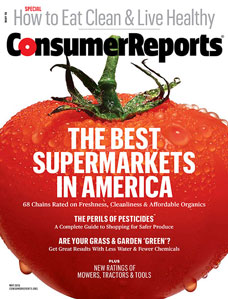|
»
» Comment
Risk Guide for 48 Fruits and Vegetables from 14 Countries; Choosing Organic Always the Safest Choice but in Many Cases Conventional Can Be As Low Risk
March 19, 2015
Yonkers, NY - by Consumer Reports - Fresh produce is an important part of a healthy diet. A new study by Consumer Reports looks at the risks of pesticide residues for 48 fruits and vegetables from around the globe to come up with guidelines to help consumers reduce their exposure to these toxic chemicals. The full article, “Eat the Peach, Not the Pesticide: A Shopper’s Guide,” is featured in the May 2015 issue of Consumer Reports and at ConsumerReports.org. An accompanying 40-page report, “Pesticide Use in Produce,” from Consumer Reports’ Food Safety and Sustainability Center provides a closer look at the consequences of pesticide use for those who produce food, wildlife, and the environment. Related to the study are results from two recent surveys each of more than 1,000 people by Consumer Reports National Research Center. In the survey conducted in April 2014, 89 percent of Americans noted that protecting the environment from chemicals such as pesticides is critical when purchasing food. In a related survey from November 2014, 85 percent of Americans said they are concerned about pesticides exposure in food; and a third of respondents to this same survey believe there is a legal limit on the number of different pesticides in food. But there isn’t a legal limit on the number of different pesticides allowed on food. Consumer Reports analyzed data from United States Department of Agriculture (USDA) and found that a third of the produce the agency tested had residues from two or more pesticides. And while for the most part these levels fell within the Environmental Protection Agency (EPA) tolerance levels, these tolerance levels are calculated for individual pesticides. The effects of these pesticide combinations are untested and unknown notes Consumer Reports. The report by the Food Safety and Sustainability Center discusses the health effects from the use of pesticides that have been documented in farmworkers. “Eating a diet rich in fruits and vegetables is important to a healthy diet,” said Dr. Urvashi Rangan, Ph.D. Executive Director of Consumer Reports' Food Safety and Sustainability Center. “Choosing organic produce is always the best option and reducing pesticide use is critical to healthier produce production. For those who can’t always afford organic, when it comes to reducing your pesticide exposure we have specific recommendations for conventional options that are just as low risk as organic.” Consumer Reports’ Findings To help consumers make better choices when shopping for produce, Consumer Reports has developed a guide based on its analysis of 12 years of data from the USDA’s Pesticide Data Program that shows the relative risk of pesticide exposure from eating 48 conventional fruits and vegetables from 14 different countries. Consumer Reports placed each produce-country combination into one of five risk categories – from very low to very high. The risk assessment included the number of pesticide residues on each food, the frequency with which they were found, and the toxicity of the pesticides. Consumer Reports analysis is based on the risk to a 3 ½-year-old child estimated to weigh 35.2 pounds because children are especially vulnerable to the dietary risks from pesticides. Adults can use this relative risk information to make informed comparisons among produce-country combinations. Consumer Reports analysis showed that, universally, organic produce falls into the low- or very low-risk categories when it comes to pesticide exposure, so consumers should choose organic fruits and vegetables when possible. If organic produce is too pricey or not available, there are often low-risk conventional options equivalent to organic. Here are the fruits and vegetables consumers should always choose organic: Consumer Reports analysis found 23 very low- and low-risk conventional produce items that are okay to buy including: bananas, cherries, oranges, broccoli, lettuce, onions and more. The complete risk guide is available on ConsumerReports.org. The Risks of Pesticides Advertisement Much of what is known about the health effects of pesticides comes from studies of farmworkers, who work with these chemicals regularly. Studies have linked long-term pesticide exposure in this group to increased risk of Alzheimer’s and Parkinson’s disease; prostate, ovarian, and other cancers; depression; and respiratory problems. Many agricultural chemicals are known or are suspected carcinogens or endocrine disruptors that can block or mimic the action of hormones. Farmworkers may be at greatest risk from pesticide exposure, but the health risks to children are also significant. Because a child’s metabolism is different than an adult’s, toxins can remain longer in a child’s body, where they can do more damage. Pesticide exposure can affect children’s development at many stages, starting in the womb. And their risk is concentrated because they eat more food relative to their body weight than adults. Even small amounts of pesticides may alter a child’s brain chemistry during critical stages of development. Consumer Reports notes that while the risks of pesticides are real, the health benefits of fruits and vegetables are, too. When possible, it’s best to choose organic or low-risk conventional produce. However, eating a diet rich in fruits and vegetables – ideally five or more servings a day – is the primary goal, even if it’s a type that falls into Consumer Reports’ very high-risk category.
|
|



